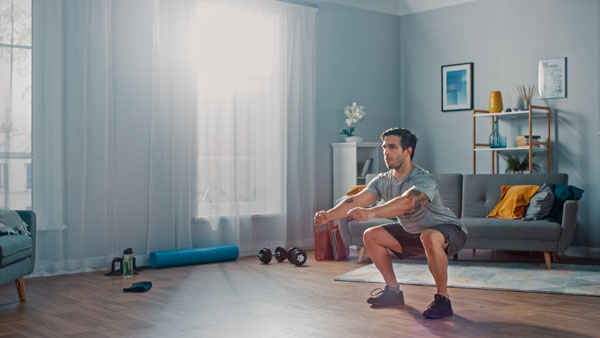Chances are you’re at home self-isolating thanks to the coronavirus pandemic that’s sweeping our country. Keeping active, especially when staying at home for such an extended period of time, is crucial to your physical and mental health. Here are some tips and tricks for working out at home to keep the blues and illness at bay.
Research Proper Form
Personal Crossfit trainer Maillard Howell says, “[The] most common mistakes are due to a lack of awareness.”By “awareness” he means body alignment and form. When you work out by yourself, it’s easy to forget to pay attention to your form. Howell says he often sees people flaring out their elbows in push-ups, tugging on the neck during sit-ups, and not engaging the body in plank. These details might seem minor, but they’ll dictate how effective your set will be and whether you’ll be in pain later. Howell says to “[do] a little research” to avoid making this mistake. Take time to explore online resources and tutorials that show you what good form looks like, and work out with purpose. Also, you should always pay attention to how your body feels.
Plan Workouts with Goals in Mind
“…Write out a plan that’s consistent with your goals,” says Nicole Ferrier, an online fitness coach. Ferrier and Howell agree that not having specific goals is a common mistake. Howell suggest not trying to follow every fitness trend or what may seem like a “quick fix.” Both he and Ferrier also suggest sticking with an approach for two weeks before switching it up.“If you don’t have solid structures in place, you can’t improve or test your strength,” she says.
Howell advises “[splitting] your days into upper-body day, lower-body day, aerobic day, rest day, and total body day…With the limited equipment at home, sessions should be focused around a finite number of bodyweight movements. The chance of overtraining a specific body part is high, and in turn, risk of injury.”
Don’t Integrate Too Many New Things at Once
Ferrier advises easing your body into trying new things. “People are jumping around a lot when they’ve never jumped before,” she says.Instead, she suggests building up to new levels of impact and intensity to reduce the chance for injury. If your body is used to working out on machines that greatly lessen the impact on the body, she explains, it can be dangerous to start running all the time. High-intensity cardio is great if you build up to it, but if you don’t, you can hurt yourself or burn out.
Engage with a Community
Howell and Ferrier agree that staying inspired is essential right now, since we’re unable to feed off each other’s workout energy. Howell suggests joining social media challenge groups to help keep you accountable. Ferrier says, “Turn on Instagram Live. If you have experience with group exercise, you already know how to perform for other people when you don’t feel like working out.”Have Fun
The most important thing, Howell and Ferrier agree, is to have fun. If you feel lost about how to set up a workout plan or get your form right, DM someone or start a discussion in the comments of a post. “Ask for help,” Howell says. “Social media has a plethora of experts and you can pick their brains.”Adapted from an article by Tracy Duncan
- ReageerComment Cancel
Call now: 973-304-0205, 344 Wagaraw Rd., Hawthorne, NJ 07506
Cho's Taekwondo Academy
Address: 344 Wagaraw Road, 2nd Floor, Hawthorne, NJ 07506
Call: 973-304-0205
Email: info@choacademyusa.com

